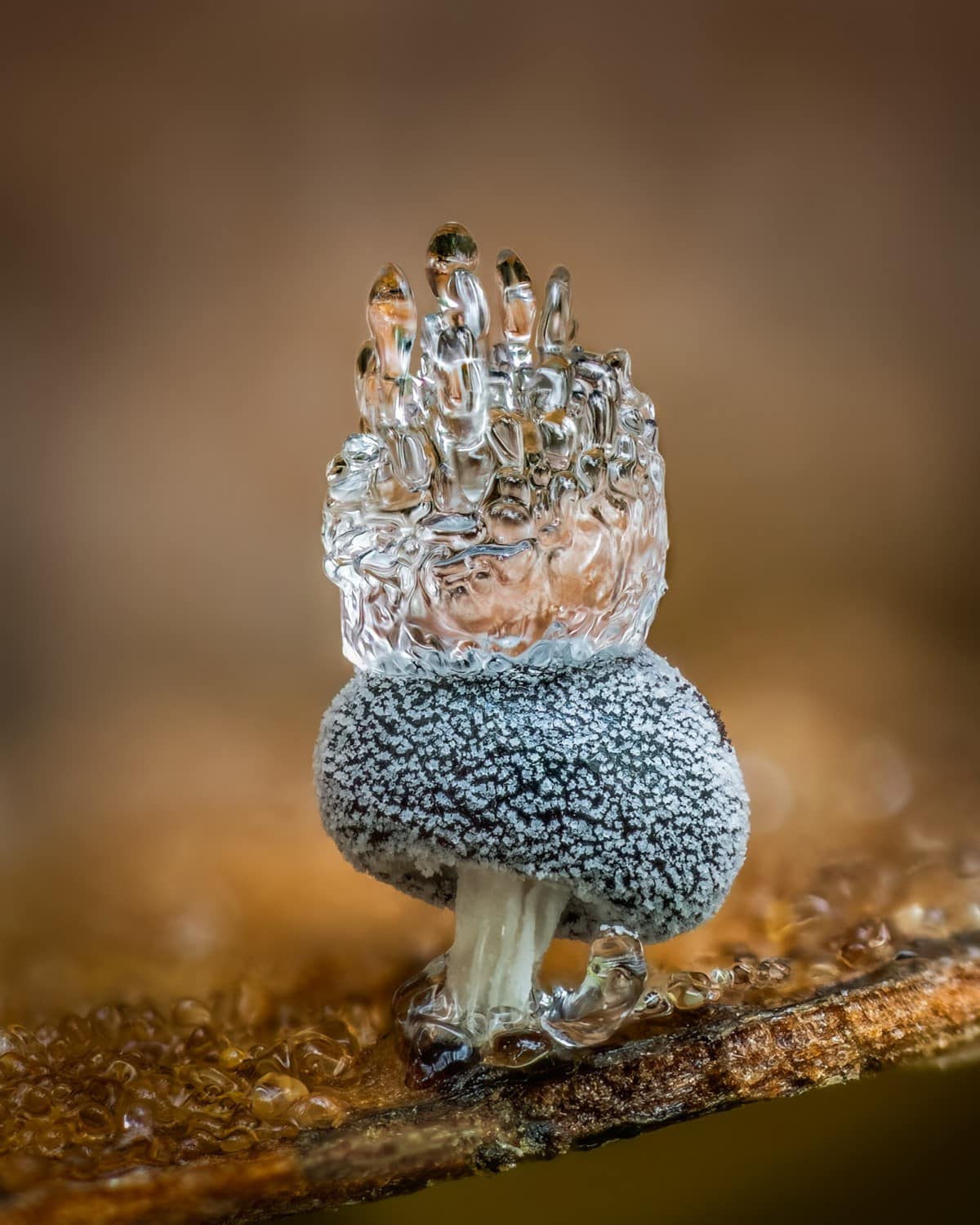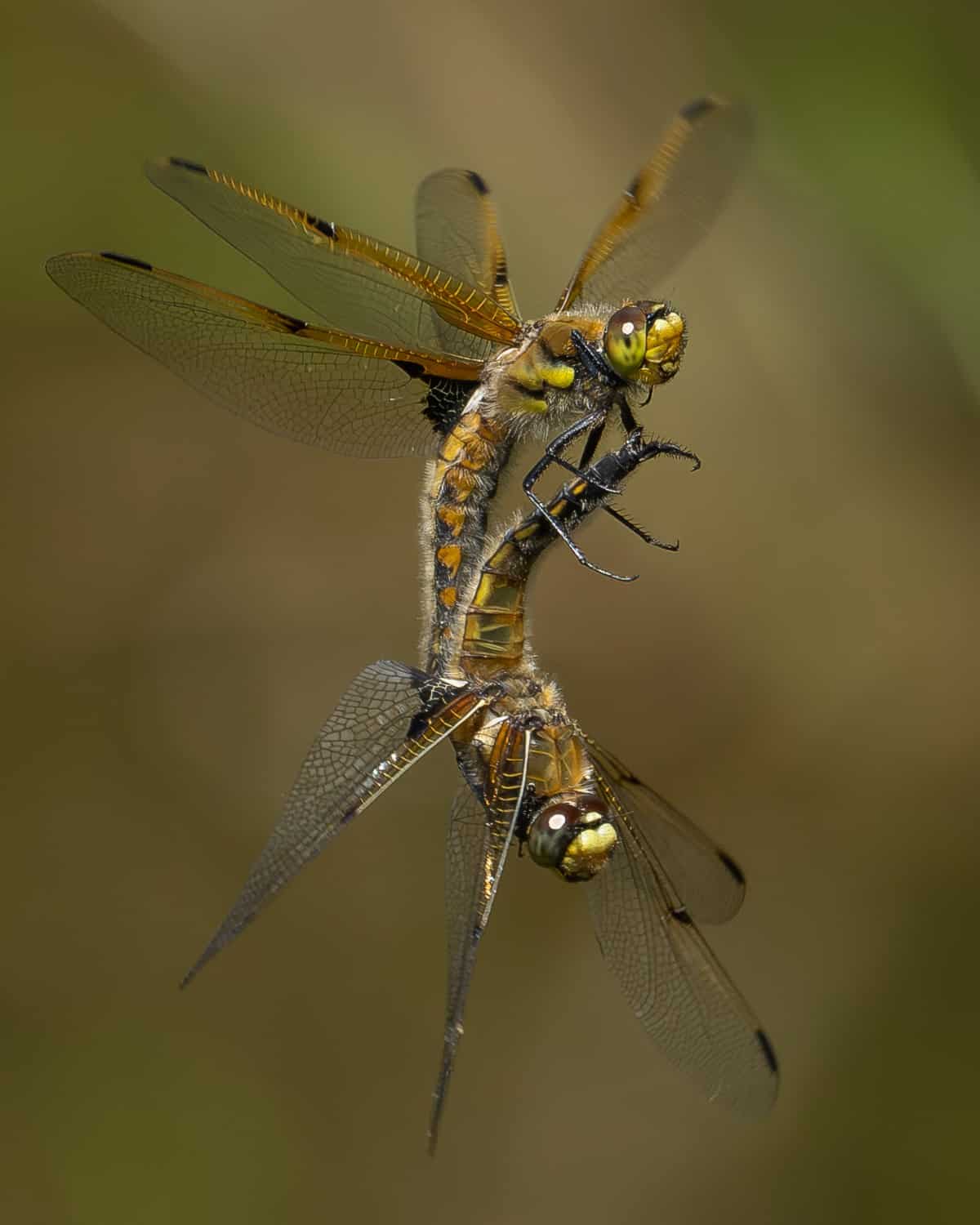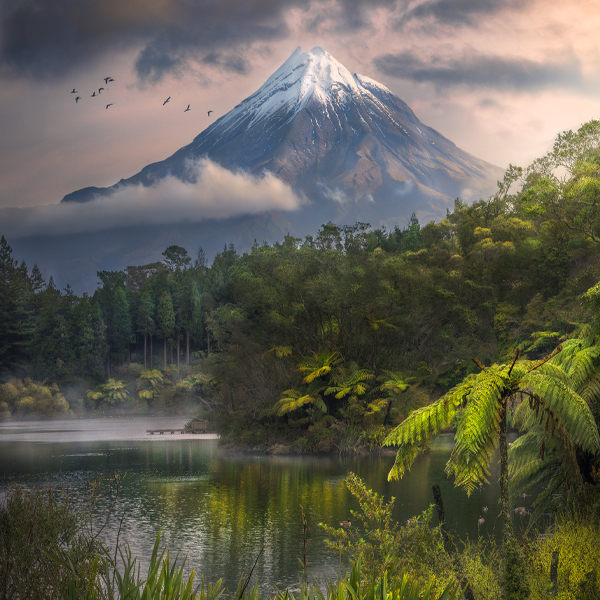
“The Bird Of The Forest” by Csaba Daróczi (Hungary). Animals 1st Place & Overall Winner.
“In the winter of 2023, I took a lot of photographs in a forest close to my home in Hungary. I found something new to photograph almost every week, and I spent several days exploring ideas and perfecting techniques. Staying curious and open-minded led me to this hollowed-out tree stump, which measured around half a meter in diameter. I carefully positioned my GoPro 11 camera inside the trunk and took a few shots. I was amazed by the results. After a few days, however, I decided the composition might be improved if I included an animal in the frame. So, I returned to the spot and placed a sunflower near the hole, which the mice and birds soon found.”
Hungarian photographer Csaba Daróczi took home the grand prize at the fifth edition of the Close-up Photographer of the Year (CUPOTY) contest. His striking black and white photo of a Eurasian nuthatch in flight was taken from inside the hollow of a tree, making for a unique composition.
Daróczi was not only named the overall winner, but he also won three different categories—Butterflies & Dragonflies, Animals, and Intimate Landscapes. It's an incredible feat, considering that CUPOTY attracted almost 12,000 entries from 67 countries. A jury of 23 brilliant photographers, scientists, naturalists, journalists, and picture editors spent over 20 hours collectively on Zoom calls to find the winners and Top 100 pictures.
In the Youth competition, 17-year-old Spanish photographer Carlos Pérez Naval was named Young Close-up Photographer of the Year. His photo of a Moorish gecko climbing a wall captured the attention of judges.
“In the wall of some houses in Calamocha—the village in Spain where I live—it’s possible to find pyrolusites. These magnesium minerals create stunning formations, which look just like petrified trees, but they are so small that they’re tricky to spot,” he shared. “I wanted to capture a gecko in the ‘petrified forest’ for a long time, but they only recently appeared in my village (probably carried in fruit baskets from hotter areas). Due to climate change, they can now survive here.”
Check out more incredible close-up, macro, and micro photography below as we share our favorite winners and finalists across all 11 categories from the fifth annual competition.
The winners of the fifth annual Close-up Photographer of the Year contest have been revealed.

“Small Wonders” by Carlos Pérez Naval (Spain). Young Close-up Photographer of the Year.
“In the wall of some houses in Calamocha – the village in Spain where I live – it’s possible to find pyrolusites. These magnesium minerals create stunning formations, which look just like petrified trees, but they are so small that they’re tricky to spot. One day, I was lucky enough to find a Moorish gecko (Tarentola mauritanica) very close to the pyrolusite’s wall, so I tried to make the most of the encounter. I wanted to capture a gecko in the ‘petrified forest’ for a long time, but they only recently appeared in my village (probably carried in fruit baskets from hotter areas). Due to climate change, they can now survive here.”

“Reflexion” by Ria Bloemendaal (Netherlands). Plants 1st Place.
“At Trompenburg Botanical Garden in Rotterdam, I saw this beautiful reflection in the water, and it immediately inspired me to make an ‘impressionist painting'.”

“Pinkaboo” by Chris Gug (USA). Underwater 3rd Place.
“For years, I had been wanting to make a relatively simple image of a golden damselfish set against a background of red sea whip coral. But on multiple trips to various South Pacific diving locations, there was always some problem with the sea whips – one branch would be broken, lack of current caused the polyps to be retracted, the damselfish was too rough… just always something to make me cringe with OCD! So when I found this little gem living in what is clearly NOT red sea whips, I had to twist my mind out of its rigidity and realize that the gorgonian coral background I was searching for was indeed a different species and was right in front of me!
As a traditional fisheye lens shooter, water-contact optics have been a game-changer in underwater wide-angle photography. While not quite as wide as a fisheye lens, they still cover a large field of vision, while maintaining far superior corner sharpness and don’t introduce the extreme barrel distortion of a fisheye lens. Using Nauticam’s revolutionary WACP-1 lens/port allowed me to use a medium zoom, and create a close-focus wide-angle view from just a few inches away that, unlike a fisheye lens, appears flat and maintains focus on the entire coral environment.”

“Dune Wrestling” by Victor Tyakht (Russia). Animals 2nd Place.
“I visited this small dune in the Kalmyk semi-desert in different months for several years. Each visit added new information about the most interesting local residents, the secret toadhead agamas. I observed their mating behavior, building new burrows, hunting insects, and territorial conflicts. It was these fights while defending their territory that were the most exciting spectacle. A whole ritual with initial “negotiations” with the help of various movements of the tail, demonstration of intimidating poses, and a preliminary warlike dance culminated in a tough fight. This is one of the moments of such a fight in which small lizards look like grappling wrestlers on a sports mat.”

“Dreamtime” by Simon Theuma (Australia). Underwater 1st Place.
“Like an intricate tapestry of the marine ecosystem, this image captures the relationship between a commensal shrimp and a mosaic sea star. Dreamtime Aboriginal art reminds us of the delicate balance that exists in the grand tapestry of our natural world – this ancient wisdom serves as an important reminder to preserve what we have. To capture this image, I needed to use a snooted strobe, which was set at an acute angle to the subject. This set-up accentuated the depth and beautiful texture of the two organisms. Additionally, I enhanced magnification by using a +15 wet lens dioptre.”

“Beach Grass” by Gerhard Vlcek (Austria). Micro 1st Place.
“This image shows a 30μm cross-section of beach grass (Ammophila arenaria) stained with Auramin O and Safranin and viewed under fluorescence blue excitation. The grass came from a friend’s garden in Vienna. For the best results, I had to slice the sample as thinly as possible. First, I fixed some stems in warm liquid polyethylene glycol. As it cools down, it turns solid, and the embedded stems were placed in a microtome and sliced with a sharp blade. Staining and preparing the sample was very tricky. I had to use the tiniest brush to manipulate the less than 1mm parts in different staining and chemical solutions before positioning the stems on the slide. After that, taking the photograph was the easy part!”

“Ice Fossiel” by Piet Haaksma (Netherlands). Intimate Landscape 2nd Place.
“In winter, many of the flooded wetlands in the Netherlands can be skated upon. The ice is often damaged, with pieces being chipped off. On one such occasion, I discovered a small chunk of ice stuck to a frozen twig that made me think of a prehistoric find.”

“The Ice Crown” by Barry Webb (UK). Fungi & Slime Moulds 1st Place.
“This 1mm tall slime mold (Didymium squamulosum) was found in leaf litter on a Buckinghamshire woodland floor in January. Attracted by the way the frost had formed a crown shape on top of the fruiting body, I had to be very careful not to breathe on it. During a previous attempt with another slime mold, my breath had melted the ice when I inadvertently got too close.”
The contest celebrates the best close-up, macro, and micro photography.

“Heart of the Sea” by Liang Fu (China). Underwater 2nd Place.
“This photograph was taken during a blackwater dive in Romblon, Philippines. Blackwater diving is a type of scuba diving that takes place at night in the open ocean, with thousands of meters of water below the boat. Divers descend a rope with underwater lights as their only orientation system. When the tide and moon phases are right, creatures from the deep migrate to shallower waters. This vertical migration is one of the most remarkable natural phenomena. During the dive, I saw something shining under my searchlight at 28 meters deep. As I swam closer to investigate, I found a lava moray eel curled into a heart shape. I was extremely fortunate to capture this moment with my camera. The eel remained at that depth for less than 10 seconds before swimming down and disappearing into the darkness.”

“Orange Isopod” by Manfred Auer (Austria). Invertebrate Portrait 2nd Place.
“I captured this shot during my early days as a macro photographer back in April. Just three months after getting my Olympus camera, I stumbled upon this incredible isopod in the woods behind my house in the beautiful south of Austria. This image is a result of merging 91 individual shots with varying focus points.”

“Tears In My Eyes” by Wim Vooijs (Netherlands). Plants 2nd Place.
“I discovered a field covered with sundew, a small carnivorous plant. There were lots of silver-studded blue butterflies flying around, and occasionally, one would get caught and trapped in the sundew. Instead of photographing one of those poor victims, I favored another approach. I wanted to capture the innocent and alluring beauty of the plant, the way a butterfly might see it in its last moments. To do this, I used a vintage Pentacon lens to capture the sundew as a pair of eyelashes on seductive eyes – the beauty of your last view.”

“Spirit of the Yucatan” by Chris Gug (USA). Plants Finalist.
“Looking through the drifting stems of lily pads in a Mexican freshwater cenote to the sky above.”

“Twisted Dandelion” by Harald Cederlund
(Sweden). Micro 3rd Place.
“This picture of a dandelion picked from my lawn was shot in my living room using a Mitutoyo10x microscope lens adapted to the camera using a 70-200mm f/4 lens as a tube lens. Using a motorized macro rail, I captured around 200 individual exposures that were combined in Zerene Stacker to produce the final image.
I often use such a setup to “poke around” inside dandelions. Using diffused light from a window to light the dandelion from behind creates a beautiful rim light, better contrast and makes the dandelion ‘glow'.”

“Comatricha Nigra” by Alexis Tinker-Tsavalas (Greek / Canada). Young 2nd Place.
“After finding a big patch of slime mold fruiting bodies under a log, I checked on them regularly for a few days until they were at just the right stage for me to photograph them. After trying out various angles and compositions I chose this perfectly arranged little group, and took a focus stack to get all of them in focus.”

“Picking Flowers” by William Steel (South Africa / UK). Animals Finalist.
“An Elephant enjoys a nutritional meal of water lily flowers as it makes its way across the Chobe River, Botswana. As flood water reaches the Chobe river (all the way from its starting point in Angola) the waterways are transformed with a wave of flowers. 2023 was one of the most incredible displays I have ever seen. I can only surmise that a combination of early, staggered flooding, alongside large volumes of water, meant that we were treated to a real spectacle of white and purple flowers. With elephants and buffalo occasionally crossing through the flowers, I knew it was just a matter of perseverance. One afternoon a mix of perfect lighting, a dense patch of flowers, and a willing elephant, made the perfect combination. Shooting from a boat and leaning over the edge with my lens almost touching the river, I was able to get the low, intimate perspective. A once-in-a-lifetime moment!”
This year's contest attracted nearly 12,000 entries from 67 different countries.

“The Wedding Guest” by Csaba Daróczi (Hungary). Butterflies & Dragonflies 1st Place.
“I was photographing a wedding in a forest clearing in the beautiful surroundings of Uzsa, Hungary. The hall lights attracted a lot of insects to rest on the windows. At one point, I saw some guests taking pictures with their phones next to one of the red lights. As I moved closer, I noticed an oak peacock moth (Antheraea yamamai) had taken up residence on the window. I waited until everyone had finished their pictures, and then it was my turn.”

“Autumn Emergence” by Jay Birmingham (UK). Fungi & Slime Moulds 2nd Place.
“I came across these honey fungi in my local woodland, just as the sun was rising and lighting up the woods with golden hues. The bonus was the bracken behind – which gave the picture a wonderfully warm autumnal feel. I captured it with a wide aperture, to isolate the subject, and to maximize the bokeh background.”

“Asymmetrical Threads” by Elizabeth Kazda (USA). Human Made 1st Place.
“I enjoy pushing the limits of my camera's capabilities and experimenting with new techniques to capture ordinary objects. My collection of art supplies includes numerous spools of colored thread from previous projects. I wanted to photograph this thread in a unique way and came up with the idea of wrapping colored strands around an open picture frame. I placed the frame on a motorized rotating platform and set my camera to multiple exposure mode. I captured 64 photos of the thread at 64 equidistant positions as I rotated the platform. Since I didn’t complete a 360° rotation, the design is asymmetrical. This is a meticulous process that requires patience. For this image, I used an in-camera multiple exposure of 64 frames to output a single Raw file.”

“Mosquito Egg Raft” by Barry Webb (UK). Insects 2nd Place.
“I spotted dozens of these tiny mosquito egg rafts on the surface of a water butt while I was working as a gardener. The rafts would not stay still long enough for me to photograph them. So I carefully fished one of the egg rafts out, using a teaspoon, and placed it in an inverted bottle top filled with water. A pebble was positioned in the middle of the bottle top, and the raft was then carefully moved onto the pebble to keep it stationary. After taking the pictures, the egg raft was returned to the water butt.”

“At the Pool” by Nicola Destefano (Italy). Insects Finalist.
“Last summer, I spent a few days on the island of Corfu. One afternoon, while at the B&B, I spotted this mantis sunbathing at the pool. I grabbed my “always ready” camera and took a few photos of this uncommon scene.”

“Letting Go” by Steve Russell (USA). Butterflies & Dragonflies 2nd Place.
“Capturing a Four-spotted skimmer dragonfly (Libellula quadrimaculata) mating is particularly difficult because they connect and mate in-flight without any warning and for only a few seconds. The moment captured in this photo is just after the male has finished depositing his sperm on the female's eggs, and they are disconnecting. She will then attempt to deposit the eggs in the water and he will hover near her to ward off other males who would like to also mate with her.”

“Ferro Field” by Jack Margerison (UK). Human Made 3rd Place.
“During the Covid lockdown in the UK, we found ourselves trapped in our homes for long periods of time. To keep myself creative, I started to make tiny pieces of artwork that I would shoot using various lights and techniques. This piece was made using black foam board as a base, onto which I poured ferrofluid. A powerful magnet underneath created the pattern. Pink paint was then added using a pipette, before converting to black and white.”

“Wood Ants Firing Acid Secretion” by René Krekels (Netherlands). Insects 1st Place.
“I had been studying the lifestyle of wood ants in the Netherlands for work when I noticed the defending ants of a very large ant’s nest seemed eager to scare me off by spraying acid towards me. Luckily it wasn’t that destructive, and it provided me with a great opportunity to photograph them defending the nest.”

“Undertow” by Csaba Daróczi (Hungary). Intimate Landscape 1st Place.
“In the first days of May, I always return to a small canal near Izsák, Hungary, where the water violet (Hottonia palustris) blooms in huge numbers. Unfortunately, flowering was delayed this year, and only the leaves were still underwater. I was about to go home when I saw a tree had fallen over the canal, and under its reflection, the plants were clearly visible. I found it a very exciting subject and played with it for a while.”

“Jumping stick” by Tibor Molnar (USA). Invertebrate Portrait 1st Place.
“When we traveled to Ecuador, I knew there would be an opportunity to see jumping sticks (Stiphra) in the Amazon region. When we found the first of several creatures, I was beyond excited. I had imagined this shot in my mind for a long time and it was incredible to actually have this opportunity to make it happen. The best way to describe these invertebrates is part walking stick, part grasshopper! When they jump, they are not particularly graceful, and they tend to tumble around completely off-balance.”
CUPOTY: Website | Facebook | Instagram






















































































